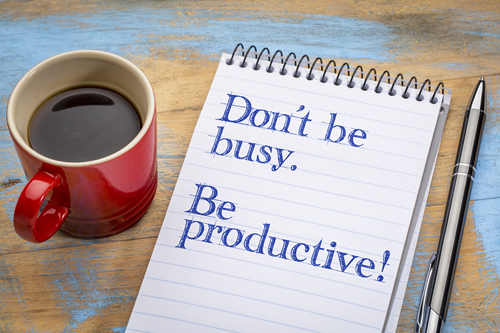I am a school principal as well as a small business owner. Because I work two jobs, I want, and I need to be productive. To me, being productive doesn’t mean working harder, it means working smarter to get through my to-do list faster while doing an excellent job. Work smart, work fast, work well. Let me share some of my tips on how to be a productive leader.
Working Smarter
- Look at the Big Picture: Understand and analyze what needs to be done. Decide what is important, what is urgent, what is a priority, and what can be delegated. Know your stuff and make sure your staff members know what is expected of them.
- Organize and Plan: Break up large projects into small tasks and attainable milestones. Organize your time with an agenda, to-do list, daily priority list and use visuals such as Post-its or large dry-erase multi-month calendars. Take time to get organized and stay organized. No matter how busy you are, schedule time to regularly meet with your staff. Make time to listen to their concerns.
- Reduce Search Time: Don’t waste time searching for information, documents, files, etc. Organize your workstation, your filing cabinets, your office, and your work environment. But most importantly, organize your digital files and your emails. Make sure your employees have all the tools, skills and space needed to get organized.
- Think-Pair-Share: For large, complex projects, consult with your staff and ask them to Think-Pair-Share (TPS). TPS is a collaborative strategy where people work together, discuss issues and find solutions. Here’s how it works: Give your employees some time to individually think and reflect on the project. Then, ask them to pair up with a colleague to discuss solutions. Finally, ask the paired employees to share with the rest of the employees at a meeting. You might be pleasantly surprised with your staff’s solutions.
Working Faster
- Keep It Together: Cluster logical and similar tasks and do them all at once. This will help improve your focus and productivity.
- One, Two, Three, Repeat: Create templates and fillable documents. Put in place processes and easy-to-follow steps for recurring tasks. Ask your employees to identify such recurring tasks and welcome their suggestions on how to improve processes.
- Slow Down to Go Faster: Take time to pause and think of the best ways to tackle a task or project. Take breaks to think about how you and your staff can be more effective, efficient and productive. Look at bending corners instead of cutting corners because we don’t want to sacrifice quality.
Working Well
- Do It Right the First Time: If you don’t have time to start over, make sure you do it well the first time. If you make a mistake, change your approach. Don’t rush through tasks and take the time to plan and organize.
- Everything’s Everything: You need to know all the information regarding a project, all the policies and regulations, hence, everything that is required to help you make good decisions and be an excellent leader. Lead by example. Focus on important and substantive details and don’t get caught up on superficial and emotional details.
- Invest in Skills Development: Invest in yourself and your staff. Provide training and professional development opportunities. Participate in webinars and sit on committees. The best way to be productive is to be surrounded by people who are competent, efficient, skilled, knowledgeable, and motivated.
It’s easy to be busy, but it’s not easy to be productive. Twenty-five years of tight deadlines, long to-do lists, commitments and professional expectations have taught me to be more productive. As a leader, the benefits are even greater. Take my advice. Don’t be a busy person, be a productive leader!

